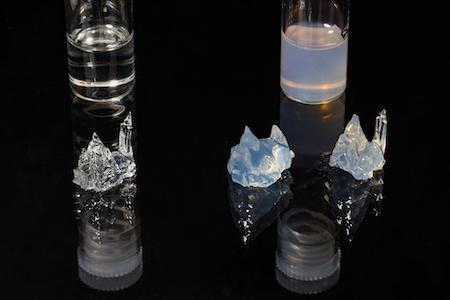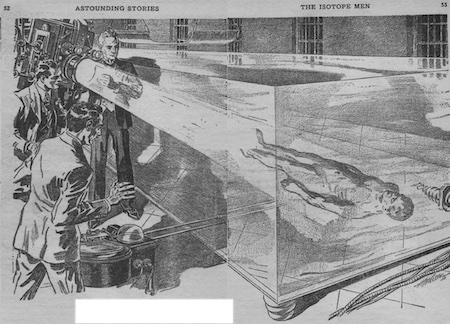Science Fiction
Dictionary
A B C D E F G H I J K L M N O P Q R S T U V W X Y Z
Prototype 3D Printer Could Print Arteries In Seconds

In 2017, EPFL's engineers in their Laboratory of Applied Photonic Devices created a 3D printer that could fabricate small objects almost instantaneously:
(Via EPFLNews)
One of the limitations of their method is that it would only work with transparent resin, which limited the kind of objects that could be fabricated.
Now, the team has worked out a way to use opaque resins, which could have many more applications:
EPFL’s 3D printer is one of the fastest in the world. Whereas most 3D printers work by depositing a material layer by layer in a process known as additive manufacturing, the EPFL one uses a volumetric method. “We pour the resin into a container and spin it,” says Christophe Moser, a professor at LAPD. “Then we shine light on the container at different angles, causing the resin to solidify wherever the accumulated energy in the resin exceeds a given level.

(Three objects printed in 3D printer:)
One made from transparent resin (left); one from opaque resin, without correction (middle); and one from opaque resin, with correction (right).© Alain Herzog 2022 EPFL
For example, a surgical team could print out arteries for a patient fabricated in seconds:
The researchers claim that with this method they can now do volumetric printing in opaque resins with almost the same precision as when printing with the transparent resins. Currently with the opaque material they are printing at a resolution of 0.1mm, and they hope to increase this to 1 micron in the future.With this method, the researchers at the institute hope to be able to print biological materials such as artificial arteries.
(Via 3DPrinting)
Obviously, this development has science fiction fans quivering with anticipation, hoping to hop across the galaxy though a series of way stations as described in Way Station, a 1963 novel written by Clifford Simak:
Moments ago the creature in the tank had rested in another tank in another station and the materializer had built up a pattern of it - not only of its body, but of its very vital force, the thing that gave it life. Then the impulse pattern had moved across the gulfs of space almost instantaneously to the receiver of this station, where the pattern had been used to duplicate the body and the mind and memory and the life of that creature now lying dead many light years distant.And in the tank the new body and the new mind and memory and life had taken almost instant form - an entirely new being, but exactly like the old one, so that the identity continued in the consciousness (the very thought only momentarily interrupted), so that to all intents and purposes the being was the same.
There were limitations to the impulse patterns, but this has nothing to do with the speed, for the impulses could cross the entire galaxy with but little lag in time.
Science fiction readers might enjoy this reference, to the Nutrient Gelatin Tank used in Nat Schachner's fascinating 1936 story The Isotope Men:
The jelly closed with a quiver over the descending form. Within its clear depths the cradled body showed like a prehistoric monster caught in a huge globule of ancient amber...
(Nutrient Gelatin Tank from 'The Isotope Men' by Nat Schachner)
Scroll down for more stories in the same category. (Story submitted 6/19/2022)
Follow this kind of news @Technovelgy.| Email | RSS | Blog It | Stumble | del.icio.us | Digg | Reddit |
Would
you like to contribute a story tip?
It's easy:
Get the URL of the story, and the related sf author, and add
it here.
Comment/Join discussion ( 0 )
Related News Stories - (" Medical ")
Natural Gait With Prosthetic Connected To Nervous System
'The leg was to function, in a way, as a servo-mechanism operated by Larry’s brain...' - Charles Recour, 1949.
Brain Implant Is Able To Capture Your Inner Dialogue
'So you see, you can hide nothing from me.'
'Pregnancy Humanoids' From China Replace Moms
'A great many of these synthetic babies were made...' - David H. Keller, 1928.
Bacteria Turns Plastic Into Pain Relief? That Gives Me An Idea.
'I guess there's nobody round this table who doesn't have a Crosswell [tapeworm] working for him in the small intestine.'
Technovelgy (that's tech-novel-gee!) is devoted to the creative science inventions and ideas of sf authors. Look for the Invention Category that interests you, the Glossary, the Invention Timeline, or see what's New.
Science Fiction
Timeline
1600-1899
1900-1939
1940's 1950's
1960's 1970's
1980's 1990's
2000's 2010's
Current News
Natural Gait With Prosthetic Connected To Nervous System
'The leg was to function, in a way, as a servo-mechanism operated by Larry’s brain...'
Woman Marries Computer, Vonnegut's Dream Comes True
'Men are made of protoplasm... Lasts forever.'
Spidery 'Walk Me' Toyota Autonomous Wheel Chair Like Star Wars
Walk along with the emperor.
Dancing Robots Taught Dance Moves
'A clockwork figure would be the thing for you...'
Proof Of Robothood - Not A Person
'Who are you people? - Show 'em.'
Indonesian Clans Battle
'The observation vehicle was of that peculiar variety used in conveying a large number of people across rough terrain.'
The 'Last Mile' In China Crowded With Delivery Robots
Yes, it's a delivery robot. On wheels.
Tornyol Microdrone Kills Mosquitoes
'The real border was defended by... a swarm of quasi-independent aerostats.'
PLATO Spacecraft, Hunter Of Habitable Planets, Now Ready
'I ... set my automatic astronomical instruments to searching for a habitable planet.'
Factory Humanoid Robots Built By Humanoid Robots
'...haven't you a section of the factory where only robot labor is employed?'
iPhone Air Fulfils Jobs' Promise From 2007 - A Giant Screen!
'... oblongs were all over the floor and surfaces.'
ChatGPT Now Participates in Group Chats
'...the city was their laboratory in human psychology.'
iPhone Pocket All Sold Out!
'A long, strong, slender net...'
Did The Yautja Have These First?
What a marvel of ingenuity the little device was!
Jetson ONE Air Races Begin, Can Air Polo Be Far Behind?
'If you're one of those rarities who haven't attended a rocket-polo "carnage", let me tell you it's a colorful affair.'
Will Space Stations Have Large Interior Spaces Again?
'They filed clumsily into the battleroom, like children in a swimming pool for the first time, clinging to the handholds along the side.'

